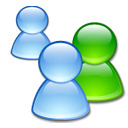The Community is the Platform - Part 1
 In a previous post, I suggested that the People are the Product, particularly in knowledge-based industries. However, when people in these contexts work and interact in a community, it becomes the platform for realizing continuous improvement and value innovation.
In a previous post, I suggested that the People are the Product, particularly in knowledge-based industries. However, when people in these contexts work and interact in a community, it becomes the platform for realizing continuous improvement and value innovation.What is a Community?
Some of the definitions for community from the Miriam-Webster dictionary include:
- a unified body of individuals
- an interacting population of various kinds of individuals
- a body of persons of common and especially professional interests scattered through a larger society
- Organizational units and teams
- Functional teams
- Cross functional teams
- Project teams
- Ad hoc communities of practice
- Informal associations and social relationships
One could view these various constructs through the lens of "community" to create a much richer, more comprehensive picture of the organization. Seeing an organization as a set of "communities" creates a powerful source of information about organizational design and behavior that can can be measured and then encouraged for sustainable, competitive value creation.
Accelerating Value Creation
In knowledge-based industries, communities are not simply the facilitators of existing collateral, but also the engines for future content and expertise. In order to optimize the agency of communities, it is important to:
- Identify and catalog the existing communities
- Assess the health of specific communities
- Provide an environment that supports community development and cooperation
- Visibility - how easy is it for others to see what you intend to do or are currently doing?
- Openness - how easy is it for others to contribute to what you are doing or need to do?
- Promotion - how ineffective are you at making others aware of your contribution and potential?
Measuring for Success
The health of the community, or its potential for sustained contribution, can be measured by focusing on the following areas:
- Interaction Levels - an assessment of the visibility, openness and promotional aspects of the community. It includes:
- Measuring new visitors to your community
- Measuring contribution ratios and activity
- Measuring dialogue and other forms of interaction
- Contribution Value - an assessment of the output of the community. It includes:
- Measuring contribution levels
- Measuring usage of content via access, ratings etc.

Comments